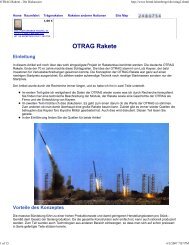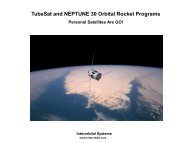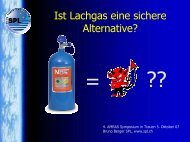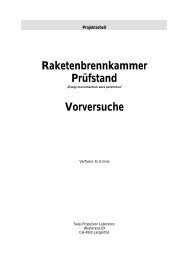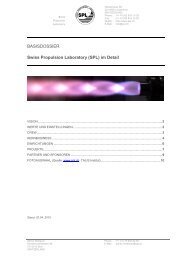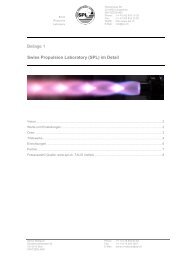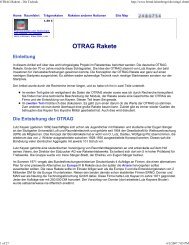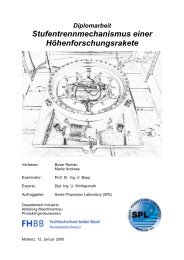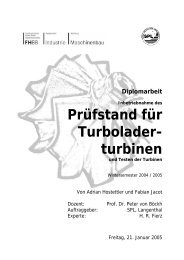You also want an ePaper? Increase the reach of your titles
YUMPU automatically turns print PDFs into web optimized ePapers that Google loves.
The modules<br />
The basic principle was the massive bundles of single very simple engines. A minimal<br />
module consisted of 4 tanks and 4 power plant. Internally, of "1-Pack", "4-Pack " and so<br />
on ever spoken to engine number. Today, Lutz Kayser of the technology in the U.S. and<br />
speaks of "Common <strong>Rocket</strong> Propulsion Modules" abbreviated CPMR or "Common<br />
<strong>Rocket</strong> Propulsion Units (CRPU). Seems a German name for the modules to have it so<br />
never existed. The same applies to the rocket. At a shareholders meeting was<br />
"Wotan"proposal, but failed to happiness. In the press were mostly of the "<strong>OTRAG</strong><br />
rocket" or "cheap rocket"is mentioned.<br />
The tanks<br />
The tanks consisted of modified pipeline pipes from the petroleum industry. They were<br />
manufactured in a special cold-rolling process for the relatively high empty weight<br />
required. The steel had ² a stress limit of 232,000 PSI [1600 N / mm^2]. The weld seam<br />
needed to be made with a spiral welding process. One important however to normal deepdrawn<br />
tubes. Each tube is 10.63 in [27 cm] thick and 9.84 ft [3 m] long. It consists of<br />
0.020” – 0.040” [0.5-1 mm] thick, low-carbon steel. A machine could produce 10 tanks a<br />
day largely automatically. Thickness for the tank was in a 1979 report called a value of<br />
0.040” [1.0 mm] and Lutz Kayser stateed in 2005 that it was 0.020” [0.5 mm]. Harry O.<br />
Ruppe writes of 0.015” [0.38 m], but at 435 PSI [30 bar] pressure. Thus one has tried<br />
tank thickness and pressure in order to optimize the best performance.<br />
Because of the thin wall of the tanks were unstable in the transverse direction and the<br />
tank pressure was needed to stabilize it, as was done with the Atlas. The tank weight with<br />
a 0.020” [0.5 mm] wall thickness was about about 2.2 lbs per foot [3.3 kg per meter]. At<br />
each tank joint was an intermediate bulkhead of 4.4 lbs [2 kg] mass. A 9.8 ft [3 m]<br />
module came to a weight of about 26.5 lb [12 kg] for the M10 bolt connections.<br />
Up to 8 of these tubes, together with a bayonet attached, form a tank of 10.6 in [27 cm]<br />
diameter and 80 ft [24 m] in length. There are also bundles of smaller lengths. (40 ft [12<br />
m] and 60 ft [18 m] long modules were planned). Each tank has a tank bottom can be<br />
interrupted, so the tanks can be filled continuously. The fuel tanks are only partially<br />
filled, the rest is air at up to 580 PSI [40 bar] initial pressure, which takes over the fuel<br />
support. Due to the emptying of the tanks, the pressure then drops to 218 PSI [15 bar] at<br />
the end.<br />
As the fuel cost combined nitric acid / diesel oil is used. This combination is far less<br />
expensive than the usual combination of hydrazine / nitrogen tetroxide. This is because<br />
the rocket on the one hand, cheaper than the competition must, on the other hand, weighs<br />
much more. Other combinations such as the use of liquid oxygen are eliminated because<br />
of the high evaporation rate in the thin tanks.<br />
Nitric acid tank has a good weight advantage. A liter weighs 1:52 kg. The addition of<br />
nitrogen tetroxide is the composition that again a little closer. In American usage as HDA<br />
(High Density Acid) or "IRFNA IV" called liquid is a mixture of 50% nitric acid and 44-<br />
49% nitrogen tetroxide and small amounts of hydrogen fluoride and water. HDA is



